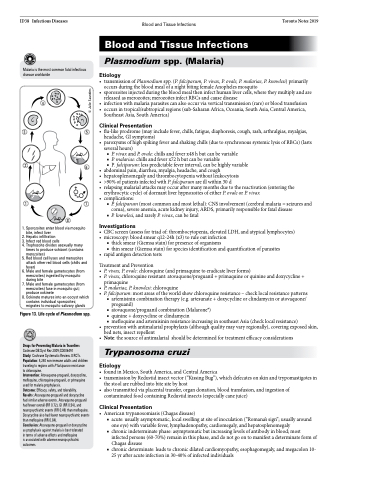Page 638 - TNFlipTest
P. 638
ID38 Infectious Diseases
Blood and Tissue Infections
Toronto Notes 2019
Malaria is the most common fatal infectious disease worldwide
4
35
26
17
8
1. Sporozoites enter blood via mosquito bite, infect liver
2. Hepatic infiltration
3. Infect red blood cells
4. Trophozoite divides asexually many
times to produce schizont (contains
merozoites)
5. Red blood cell lyses and merozoites
attack other red blood cells (chills and
fever)
6. Male and female gametocytes (from
merozoites) ingested by mosquito
during bite
7. Male and female gametocytes (from
merozoites) fuse in mosquito gut;
produce ookinete
8. Ookinete matures into an oocyst which
contains individual sporozoites; migrates to mosquito salivary glands
Blood and Tissue Infections
Plasmodium spp. (Malaria)
Etiology
• transmissionofPlasmodiumspp.(P.falciparum,P.vivax,P.ovale,P.malariae,P.knowlesi)primarily occurs during the blood meal of a night biting female Anopheles mosquito
• sporozoitesinjectedduringthebloodmealtheninfecthumanlivercells,wheretheymultiplyandare released as merozoites; merozoites infect RBCs and cause disease
• infection with malaria parasites can also occur via vertical transmission (rare) or blood transfusion • occursintropical/subtropicalregions(sub-SaharanAfrica,Oceania,SouthAsia,CentralAmerica,
Southeast Asia, South America)
Clinical Presentation
• flu-likeprodrome(mayincludefever,chills,fatigue,diaphoresis,cough,rash,arthralgias,myalgias,
•
• • • •
•
headache, GI symptoms) paroxysmsofhighspikingfeverandshakingchills(duetosynchronoussystemiclysisofRBCs)(lasts several hours)
■ P. vivax and P. ovale: chills and fever x48 h but can be variable
■ P. malariae: chills and fever x72 h but can be variable
■ P. falciparum: less predictable fever interval, can be highly variable
abdominalpain,diarrhea,myalgia,headache,andcough hepatosplenomegalyandthrombocytopeniawithoutleukocytosis >90%ofpatientsinfectedwithP.falciparumareillwithin30d relapsingmalarialattacksmayoccuraftermanymonthsduetothereactivation(enteringthe erythrocytic cycle) of dormant liver hypnozoites of either P. ovale or P. vivax
complications:
■ P. falciparum (most common and most lethal): CNS involvement (cerebral malaria = seizures and
coma), severe anemia, acute kidney injury, ARDS, primarily responsible for fatal disease ■ P. knowlesi, and rarely P. vivax, can be fatal
Figure 13. Life cycle of Plasmodium spp.
Drugs for Preventing Malaria in Travellers
Cochrane DB Syst Rev 2009;CD006491
Study: Cochrane Systematic Review. 8 RCTs. Population: 4,240 non-immune adults and children traveling to regions with P. falciparum resistance
to chloroquine.
Intervention: Atovaquone-proguanil, doxycycline, mefloquine, chloroquine-proguanil, or primaquine used for malaria prophylaxsis.
Outcome: Efficacy, safety, and tolerability.
Results: Atovaquone-proguanil and doxycycline had similar adverse events. Atovaquone-proguanil had fewer overall (RR 0.72), GI (RR 0.54), and neuropsychiatric events (RR 0.49) than mefloquine. Doxycycline also had fewer neuropsychiatric events than mefloquine (RR 0.84).
Conclusion: Atovaquone-proguanil or doxycycline as prophylaxis against malaria is best tolerated
in terms of adverse effects and mefloquine
is associated with adverse neuropsychiatric outcomes.
Investigations
• CBC screen (assess for triad of: thrombocytopenia, elevated LDH, and atypical lymphocytes) • microscopy:bloodsmearq12-24h(x3)toruleoutinfection
■ thick smear (Giemsa stain) for presence of organisms
■ thin smear (Giemsa stain) for species identification and quantification of parasites • rapidantigendetectiontests
Treatment and Prevention
• P.vivax,P.ovale:chloroquine(andprimaquinetoeradicateliverforms)
• P.vivax,chloroquineresistant:atovaquone/proguanil+primaquineorquinineanddoxycycline+
primaquine
• P. malariae, P. knowlesi: chloroquine
• P.falciparum:mostareasoftheworldshowchloroquineresistance–checklocalresistancepatterns
■ artemisinin combination therapy (e.g. artesunate + doxycycline or clindamycin or atovaquone/ proguanil)
■ atovaquone/proguanil combination (Malarone®)
■ quinine + doxycycline or clindamycin
■ mefloquine and artemisinin resistance increasing in southeast Asia (check local resistance)
• preventionwithantimalarialprophylaxis(althoughqualitymayvaryregionally),coveringexposedskin, bed nets, insect repellent
• Note: the source of antimalarial should be determined for treatment efficacy considerations Trypanosoma cruzi
Etiology
• foundinMexico,SouthAmerica,andCentralAmerica
• transmissionbyReduviidinsectvector(“KissingBug”),whichdefecatesonskinandtrypomastigotesin
the stool are rubbed into bite site by host
• also transmitted via placental transfer, organ donation, blood transfusion, and ingestion of
contaminated food containing Reduviid insects (especially cane juice)
Clinical Presentation
• Americantrypanosomiasis(Chagasdisease)
■ acute: usually asymptomatic, local swelling at site of inoculation (“Romana’s sign”; usually around
one eye) with variable fever, lymphadenopathy, cardiomegaly, and hepatosplenomegaly
■ chronic indeterminate phase: asymptomatic but increasing levels of antibody in blood; most
infected persons (60-70%) remain in this phase, and do not go on to manifest a determinate form of
Chagas disease
■ chronic determinate: leads to chronic dilated cardiomyopathy, esophagomegaly, and megacolon 10-
25 yr after acute infection in 30-40% of infected individuals
© Julie Saunders


